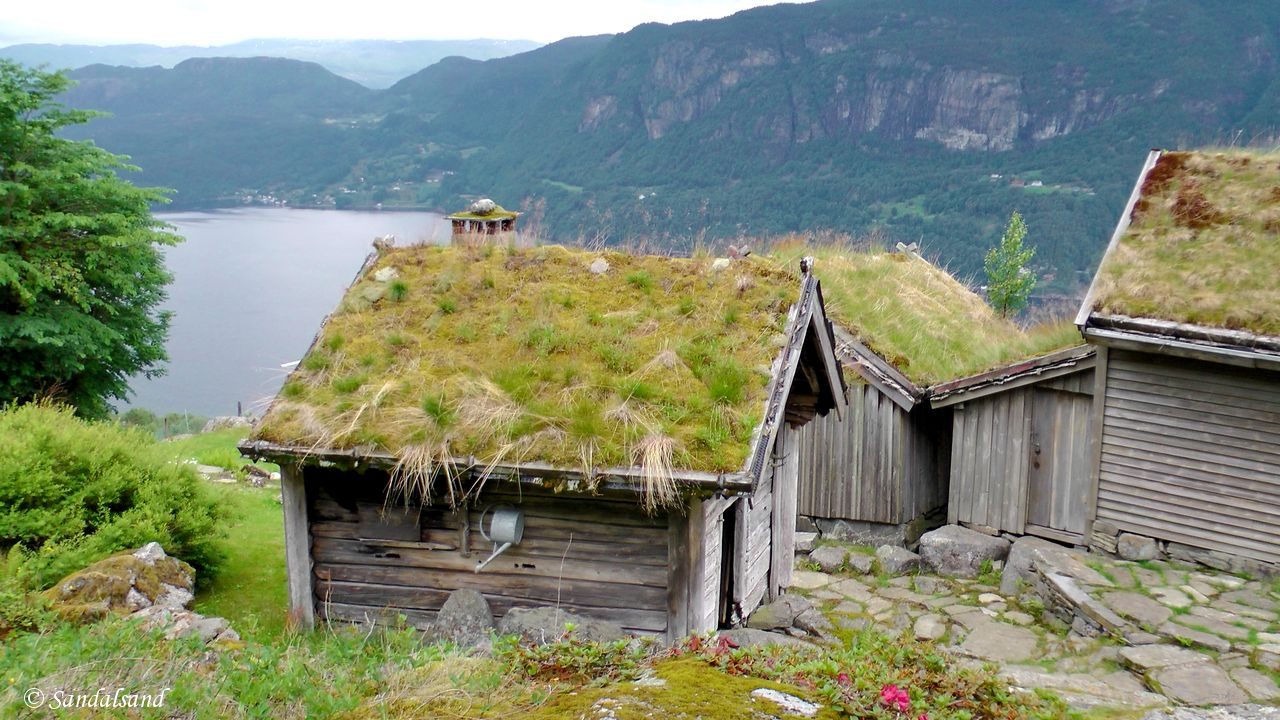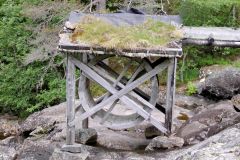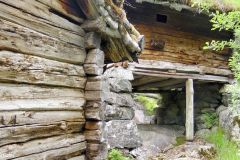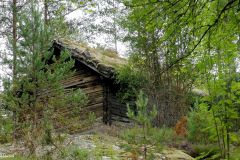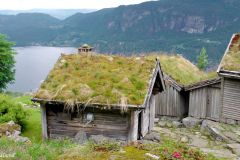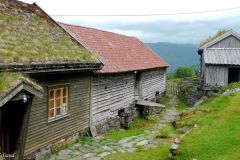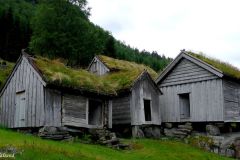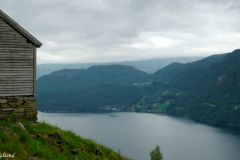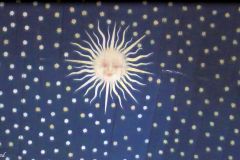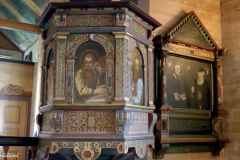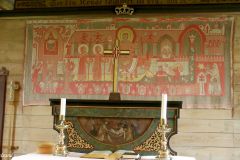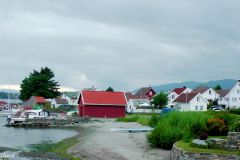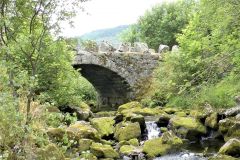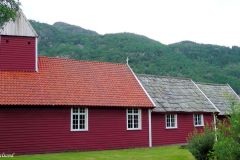Day 2 of the Boknafjord road trip takes us from the industrial town of Sauda to fantastic old farmsteads in Suldal and beyond on roads that are attractions in their own right. Cutting through the Ryfylke region back to Stavanger completes a most wonderful and intense round trip.
Map
The map below gives a sketchy overview of the roundtrip. Zoom in and out, and open the map in a new tab as you like. Details are presented in the text.
Sauda – the smelting works town
Sauda is as far into the fjords of Ryfylke in Western Norway it is possible to get. Arriving late last night we made a short walk around town and found a decent restaurant (Mama Rosa). The Kløver Hotel was as dull as expected, but quite alright and the only hotel left in town. This morning we got to see more of Sauda.
My conclusion is: Sauda has a rather drab town centre. There has not been much development over the years, seemingly only a couple of new buildings each decade for the last hundred years. The most recent seemed to be a one-storey supermarket in black concrete with windows only on the front. The consequence is a centre without distinct character, just like any other small town in the Norwegian countryside.
Åbøbyen, the factory town
What sets Sauda apart as a place worth visiting, is the part of town called Åbøbyen. This is a “factory town” along international lines, ie homes that the smelting works factory built for its workers. They started in 1916 and continued right up until 1940. Around 120 houses remain, in addition to a hospital, school, shops, tree lined streets, and parks. This “America town” as it is called even had American fire hydrants. The standard was above what was common in Norwegian cities elsewhere, and of course there was a variation within the Åbøbyen as well. Workers (closest to the polluting factory), foremen, functionaries and top management (on top of the slope) were offered different standards of accommodation.
At the request of its employees the factory owners provided support to build houses in another part of Sauda, for self-ownership. This place is called Egnehjem (meaning “own home”).
Åbøbyen has been declared a national heritage, and the factory is still going more or less strong. Why put a ferro-alloy smelting works factory at the bottom of a Norwegian fjord in the first place? The reason is simple: Cheap electricity.
“Due to low prices, vast quantities of power, proximity to international markets, an ice-free coastline etc. Norwegian hydropower resources were highly attractive for the establishment of new ventures at the turn of the 19th Century / early 20th Century, when technological and financial developments had reached a new stage in Europe and North America.” This quote is from the Norwegian application to put the Rjukan and Odda industrial communities on the UNESCO World Heritage List. Sauda is a good runner-up.
The point is: Sauda played a key part in the Norwegian industrial history: Here the country, the modern Norway was forged – so to speak.
The illustration photo on this video is the town hall of Sauda.
Suldal – salmon fishing and remote farms
Sauda has a fascinating history as a comparatively large town with an industrial past. On our second day of the Boknafjord round trip we were now heading south with a totally different agenda. The road southward in the region of Ryfylke is an attraction in itself, namely the National Tourist Route R13, also called Ryfylkeveien.
We could have opted for an alternative out of Sauda. The route north to Røldal and then south to Suldal is probably amazing. We did fear it would be time consuming, so we turned south in the direction we arrived yesterday, making a stop at the nice waterfall of Svanndal. A large waterfall crossing underneath a national tourist route means that the authorities would go to great lengths to ensure that visitors will have a fine experience. Success.

At Ropeid we boarded the first of three ferries this day. It was a short ride across the fjord to Sand, the centre of the municipality of Suldal. Let me just add that the new waiting room on the quay at Ropeid was absolutely fascinating: glass, steel, wires and rocks in pure harmony.
.
Suldal has much to offer in terms of sightseeing, including several farmsteads. View this map from Ryfylkemuseet. Sand centre itself even has a small museum which might be worth a visit. A walk along the quay is interesting as well. We made it simple, drove through the centre of town and headed straight for the most famous old farmstead in the region of Ryfylke, Kolbeinstveit.
Suldal is a valley at some parts wide and open, in other parts narrow and dark. The valley has a river, called Suldalslågen. There are some very picturesque photo angles to choose from, especially on the narrower parts where the river cuts with great speed downstream.
If you’re not into photography you may want to find another “angle” – go for the salmon. (Obtain a permit first.) We had been here before, but first-timers are advised to have a peer into the stream of Sandsfossen and the Salmon studio. It’s like a real-life aquarium, but don’t bet on actually seeing the large salmons.
Farmstead of Kolbeinstveit
Halfway up the valley, to where Suldalslågen departs from the lake of Suldalsvatnet, we found what we were looking for. Kolbeinstveit is probably the most important museum of cultural history in Ryfylke, and has been for a long time.
We had a look at the region’s oldest wooden building, the Guggedalsloft from 1281, and we had a guided tour of the main house and the surrounding farm buildings. The kittens were playing, the hen were laying eggs and the luncheon plate was good.
Farmstead of Li
Norway is a special interest country – you have to be Norwegian born to be satisfied with living on such a remote place on the Mother Earth. What’s more, one of the most popular TV series of all times is about people living in the most remote places of them all. There are plenty of farmsteads to choose from along the fjords or in the mountains. The series is called something like “where no one would believe anyone could live…”.
We were now heading to Litunet, a tiny farm high above the Hylsfjord. None of us knew of it and it had only recently been turned into a museum. It looked fantastic on the pictures we had seen and it would have been a perfect candidate for the TV show. Have a look at this picture collection and make up your own mind.
The farm consists of 13 buildings set in a rather steep hillside 285 metres above the fjord. There is a road of sorts running to it, so driving there is not a big obstacle. We were given a good guided orientation of the various buildings and life on the farmstead.
This place is of course officially a national heritage, it is truly amazing and is going to be a highlight on anyone’s itinerary in Norway. When in the county of Rogaland, visit the Lysefjord and Li!
Jelsa – the 16th century trading post
Our next stop was the historically important trading post at Jelsa. Dating back to the 1600s it is a lovely place, but few if any buildings are actually that old. To get there, we needed to head back towards Sand on the Road 13 and then take county road 517 at Lovravatnet south of Sand.
Jelsa of today have some permanent residents, but many of the seaside boathouses and residencial houses are owned by city people from Stavanger coming here on vacations. They do have beautiful surroundings.
For the casual visitor like us, Jelsa has a couple of interesting buildings worth a stop. We were lucky and received the third guided orientation of the day. The Ryfylke Museum runs the church and an old schoolhouse too.
The church was originally built in renaissance style but has been altered much over the years. The original decoration work is best seen inside. The schoolhouse dates back to 1774 at a time when education was a scarce commodity. It was even open for children of “strandsittere” (read about this low income group in the blog post about another Western Norway trading port, Solvorn).
Last year’s road trip in Western Norway had a description of what a typical road in this region would look like: narrow, steep down to a fjord, high mountain above. If you are ever to drive such a road, take this one, the county road 686 between Jelsa and Erfjord back to Road 13. The mountains are not extremely high, but the scenery is stunning nonetheless.
Municipality of Hjelmeland
That meant we were about to leave Suldal and continued our trip on narrow roads south to catch the Nesvik-Hjelmeland ferry. We were lucky, driving on-board a couple of minutes before departure.
The Ryfylke Museum has many activities in this region and Vigatunet in Hjelmeland was in my planning document described as a “must-see”. It appears today as it did in 1821. I had also made a mention of the museum on the Hjelmeland pier. It contains some objects, but I concluded that it was hardly worth a visit. In addition I had taken a note of the detour to the idyllic places of Fister and Randøy.
We were running short of time, it was getting late, and we dropped all that. Instead we made a short stop at the old stone bridge at Hausken and a longer stop at the Årdal Old Church. Apparantly open till 1800 every day we were an hour late. Fortunately it was unlocked and we had a good look around. The church has a fascinating three-layered exterior and the interior decoration from the 1600s was intrigueing as well.
Arriving at the ferry quay at Tau the evening was setting, we were utterly satisfied, and we decided to return to Stavanger and finish our Tour de Boknafjord.
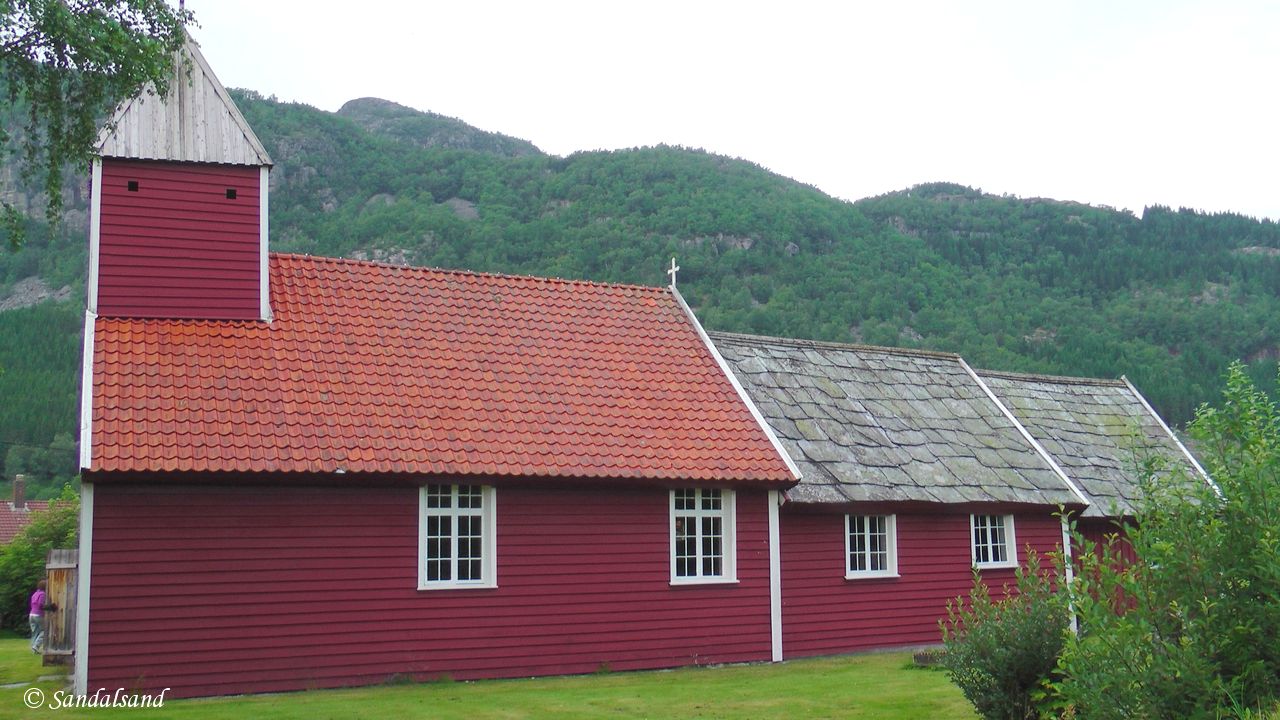
Discover even more – southern Rogaland in a nutshell
There is certainly a lot more to be seen around here. In my preparations I had included a continuation fromTau south on the Rv13 to Jørpeland, Forsand and the prehistoric village of Landa. (By the way, the road to the Pulpit Rock hiking trail deviates from the Jørpeland-Forsand road.) From Forsand we could take the ferry Oanes-Lauvvik and return to Stavanger via Sandnes. That would have taken us two-three more hours.
Actually, there is a ferry from Lauvvik into Høgsfjord and Lysefjord to Lysebotn. This may form part of a southern Rogaland road trip. Here is an outline:
- Take the ferry from Lauvvik in Sandnes into the Lysefjord. Read about the ferry ride and see video here. In Lysebotn experience base jumpers with their wild screams as they jump off the cliffs almost a thousand metres above us.
- Continue up the serpentine road to the restaurant called the Eagle’s Nest. This is the starting point for hikes to Kjerag, the ultimate Norwegian mountain experience. Read more and watch video.
- Continue by car across polished rocks to the valley of Sirdal and visit the museums and farmsteads there.
- Cross over to the Hunnadalen valley and descend into the lowlands only to make a stop at Byrkjedalstunet.
- Upon reaching the main road E39 turn south until Flekkefjord (Hollenderbyen), and then drive northwest on the North Sea Route, Road 44 passing the Helleren houses, Sogndalstrand (Stronnå) and Egersund (Okka By) on the way to Sandnes and Stavanger.
Further reading
The website Everytrail offers a very good overview as well as in-depth descriptions of sights in Ryfylke, roughly the region covered by Day 2 in this blog post. Their description may be downloaded to your smart phone directly or by a very good app called Ryfylke Multiguide. (Tripadvisor offers the same information.)
Read about Day 1 of this Boknafjorden road trip.
There are many more relevant articles on this blog. Read my introduction to Western Norway, the fjord country. These posts all have videos describing them in more detail. The videos are collected in a Norway playlist on my YouTube channel.

